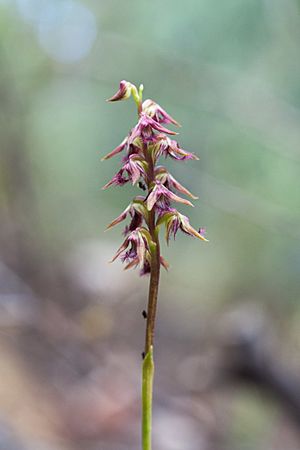Brindabella midge orchid facts for kids
Quick facts for kids Brindabella midge orchid |
|
|---|---|
 |
|
| In the Namadgi National Park | |
| Conservation status | |
| Scientific classification | |
| Genus: |
Genoplesium
|
| Species: |
ectopum
|
| Synonyms | |
|
|
The Brindabella midge orchid (scientific name: Genoplesium ectopum) is a tiny and special orchid that only grows in the Australian Capital Territory (ACT) in Australia. It's also sometimes called the Brindabella spider orchid or ectopic midge orchid. This small plant has a single thin leaf and can have up to 35 small flowers. These flowers are usually green and reddish-purple. You can only find this rare orchid in the Brindabella Range, growing in Eucalyptus forests.
What it Looks Like
The Brindabella midge orchid is a perennial plant, meaning it lives for more than two years. It grows from an underground tuber (like a small potato). It has one thin leaf that is about 100 to 250 mm (4 to 10 inches) long. This leaf is joined to the flowering stem, with the free part of the leaf being about 15 to 20 mm (0.6 to 0.8 inches) long.
The plant produces between 15 and 35 small flowers. These flowers are green and reddish-purple. They grow along a stem that can reach 20 to 40 mm (0.8 to 1.6 inches) tall. This stem is much taller than the leaf. Each flower is about 5 mm (0.2 inches) long and wide.
Interestingly, the flowers are upside down. This means the labellum (a special petal) is above the column (the central part of the flower) instead of below it. The top sepal (part of the outer flower) is 3 to 4 mm (0.1 to 0.2 inches) long. The side sepals are 4 to 5 mm (0.16 to 0.20 inches) long and spread out. The petals are about 3 mm (0.1 inches) long and have tiny hairs on their edges.
The labellum is purple and about 4 mm (0.16 inches) long. It has coarse hairs up to 2 mm (0.08 inches) long. These hairs make the labellum vibrate even in a slight breeze. There is a thick part called a callus in the middle of the labellum. This orchid flowers from January to March.
How it Got its Name
The Brindabella midge orchid was first officially described in 1999. A botanist named David Jones found a sample of the plant in the Brindabella Ranges. He published its description in a magazine called The Orchadian.
In 2002, David Jones and another botanist, Mark Alwin Clements, changed its scientific name to Corunastylis ectopa. The second part of its scientific name, ectopum, comes from an Ancient Greek word ektopos. This word means "out of place".
Where it Lives
The Brindabella midge orchid is very rare. It is only known from one specific spot in the Brindabella Range. This location is about 980 meters (3,215 feet) above sea level. It grows in Eucalyptus forests there.
Protecting This Orchid
This special midge orchid is in danger. The entire group of these orchids grows very close to a road embankment, within 10 meters (33 feet). This area is easily affected by erosion (when soil washes away).
The number of these orchids can change a lot. After bushfires and dry periods, there were only about 35 plants. Now, there are about 110.
The main dangers to the Brindabella midge orchid include:
- Erosion from the nearby road.
- Roadworks that might disturb its habitat.
- Weeds growing and taking over its space.
- Other shrubs growing too much.
- Using herbicides (weed killers) incorrectly.
Because it is so rare and faces many threats, the Brindabella midge orchid is listed as "critically endangered". This means it is at a very high risk of disappearing from the wild. This listing is under Australia's Environment Protection and Biodiversity Conservation Act 1999 (EPBC Act).


